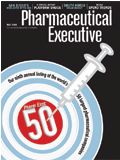The Incredible Shrinking Dollar
Pharmaceutical Executive
A plunging currency and other economic turmoil shouldn't phase pharma, right? Yes and no
One remarkable thing about the drug industry is that, for all its problems, the credit crisis currently shaking financial markets is having only marginal—and curious—effects. In fact, in hard economic times the importance of pharma and its products emerges in starkest relief. After all, even if people lose their jobs and houses, they still take—or at least need—their Lipitor and Prozac.

For better or worse, it looks like drugmakers will feel very important for the foreseeable future, according to a new CEO survey by the Financial Services Forum. The trade group, which reps 20 top banking and investment firms, reported that most execs predict a prolonged recession.
Drubbing the Dow
Ironically, what's bad for the market can be good for Big Pharma, according to the Motley Fool's Brian Lawler. During the past two recessions, Big Pharma's index beat both the S&P 500 and the Dow—big time.
Based on Lawler's calculations, during the downturn from July 1990 to March 1991, the large cap's returns were 21.7 percent, compared to the S&P's 3.5 percent and the Dow's 1 percent. During the recession of March to November 2001, the large cap's 1.8 percent loss beat the S&P's 12.6 percent loss and the Dow's 11.7 percent fall. Given this track record, Lawler expects a growing number of investors to bet on large cap stocks to "recession-proof" their portfolios.
But the dramatic devaluation of the dollar is having a more interesting effect on pharma. For one thing, it's made the industry's 1Q '08 earnings look a little less negative. "It provides a tailwind to every company that reports in dollars," says Miller Tabac's Les Funtleyder. "They get a little bump."
Pfizer, for example, reported that first quarter revenue ($11.85 billion) was down 5 percent; if not for the battered buck bumping the value of overseas sales, that would have been 10 percent. Still, a top-line tailwind doesn't mean a bottom-line boost. "Pfizer reported a $5 net gain in revenue from the falling dollar, but that didn't translate into a $5 per-share gain," said Lawler. "The gain was three cents."
Connecting the Dots
With the greenback at a 20-year low (it has fallen 15 percent against both the euro and the yen in the past year alone), America has become a bargain basement of assets. Accordingly, in reporting on Takeda Pharmaceuticals' $8.8 billion purchase of Millenium, Forbes' Jeremy Bogaisky wrote, "For foreign pharmaceutical companies with deep pockets, these are the best of times to make inroads in the lucrative US market."
The news that Japan's biggest drugmaker would pay—in cash—16 times the US biotech's expected '08 sales was flat-out stunning. But what it reveals about our imploding economy, and how it may impact pharma M&A dynamics, may be even more significant. "It's a deal that would have been impossible from any US player," opined InVivo.com. The-Street.com's Adam Feuerstein agreed: "US Big Pharma, handicapped by the weak dollar and poor credit markets, will have a tough time matching up against overseas competitors."
Business reporters and bloggers have been quick to connect the dots: From Takeda's acquisition of Millenium in March, to Eisai's acquisition of mgi Pharma in December ($3.9 billion), to Astellas' acquisition of Agensys in November ($387 million). And that's just Japanese Big Pharma. In retrospect, AstraZeneca's $15.6 billion acquisition of MedImmune last April may have marked the kickoff of the (weakened) dollar sale.
The notion of America's drug giants being left in the dust in the race for biotech's best bets is pretty hard to credit. Still, the current financial crisis may be subtly changing the rules of the game—especially if the downturn doesn't hit bottom until, say, 2010 or later.
Of course, it's easy to exaggerate the significance of this trend. No one is saying that foreign pharma is going to descend on our shores in droves, like the foreign shoppers swarming Fifth Avenue for bargains. Then again, as Pharm Exec went to press, Glaxo announced it was buying Sirtris Pharmaceuticals for $720 million. We're just sayin.'

Beyond the Prescription: Pharma's Role in Digital Health Conversations
April 1st 2025Join us for an insightful conversation with Jennifer Harakal, Head of Regulatory Affairs at Canopy Life Sciences, as we unpack the evolving intersection of social media and healthcare decisions. Discover how pharmaceutical companies can navigate regulatory challenges while meaningfully engaging with consumers in digital spaces. Jennifer shares expert strategies for responsible marketing, working with influencers, and creating educational content that bridges the gap between patients and healthcare providers. A must-listen for pharma marketers looking to build trust and compliance in today's social media landscape.
Beyond the Prescription: The Role Pharma Plays in Digital Health Conversations
April 1st 2025As social media continues to influence healthcare communication, it presents both challenges and opportunities for the pharmaceutical industry. In this interview, Jennifer Harakal of Canopy Life Sciences discusses balancing compliance with effective digital engagement to build trust and facilitate meaningful healthcare conversations.